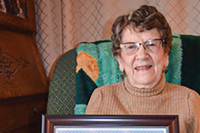Bottoms up! Bryson City brewery opens
Beer brewing in Bryson City just took on a whole new look this weekend when Nantahala Brewing Company threw open the doors of its brand new tasting room. The town’s fledgling brewery welcomed friends and fans into its front room on Depot Street, which they’ve transformed into a rustic, high-ceiling tasting room – a beer bar to accompany the brewing operation that’s been cranking in the back for some time now.
Joe Rowland, head of the company’s marketing and part owner of the business, said that they’re thrilled to be able to serve their own brews. In fact, said Rowland, it’s the key to their business model, along with the self-distribution plan they’ve been working in the area.
“We want to be the beer destination in the area,” said Rowland, and with their tasting room just across the street from the Great Smoky Mountains Railway, they hope to pull in the droves of tourists that flock to the town in warmer weather.
For now, they’re pulling four of their own taps – Noon Day IPA, Appalachian Trail Extra Pale Ale, Bryson City Brown Ale and Eddy Out Stout – as well as a couple of guest spots reserved for brews from neighboring Greenman Brewing in Asheville. But Rowland says that they hope one day soon to be serving upwards of 20 different beer varieties, some of their own mixed with the plethora of other local brewers in the region.
And the region is replete with hometown craft breweries, a product, said Rowland, of the friendly environment North Carolina offers breweries.
Though the brewery taxes are high, he said, this is one of the only places in the country that affords beer-makers the right of self-distribution, allowing them to sell and send to restaurants, bars and stores themselves, cutting out the costly middleman.
Still, said Rowland, opening up in such a small location that’s so reliant on seasonal tourist traffic hasn’t been an easy proposition for the company, owned by himself and brewer Chris Collier.
“The brewing community is a very small community,” said Rowland, “and most of our friends thought we were insane.”
But sanity notwithstanding, they’ve been successful so far, getting their products into stores and restaurants from Weaverville to Murphy and even scoring places in Charlotte and Winston Salem.
Rowland said he was thrilled by the local response to the tasting room’s opening, too; they welcomed more than 120 visitors on Friday night alone, with only a few days’ notice.
“It’s been pretty huge,” said Rowland of the response, and with the opening comes a solution to one of the company’s perennial problems — regular hours.
When it was just a brewery, it wasn’t always easy for eager customers to catch someone at the warehouse. Now, those in search of a good beer and a good time know just when and where to come for them.
And for such a small community, Rowland said the regional response to their product has been pretty impressive.
“There’s a huge appetite for it here,” Rowland said.
This doesn’t really surprise Paul Gatza. He’s the director of the Brewer’s Association, a national organization that pretty much lives up to its straightforward name.
“All the consumer trends are pointing to a bright future for craft breweries,” said Gatza, which is good news for locals like Nantahala.
Technically speaking, a craft brewery is small, independent and brews their product in line with traditional beer-making techniques.
And those are qualities that appeal greatly to younger American consumers, even in this slouchy economy. While the major domestic breweries have shown a downturn in profits, the craft-brew revolution has meant a spike in profit for craft breweries, even in the most dire recession years.
“I think especially with the younger legal-drinking-age adults, they’ve been able to discover the world of craft beers themselves,” said Gatza. “There’s qualities of the small, local, independent that they can identify with in themselves.”
And with North Carolina being one of the most craft-brewery friendly states in the nation, it’s no wonder that last year, Asheville snatched the annually bestowed Beer City USA title from Portland, Ore., long crowned the nation’s best city for finding good brews.
Rowland and his company are happy to ride that craft-brew wave, and he’s confident enough in their product that even if the wave crests, they’ll still find an audience willing to shell out for the taste and experience that no other shop in the city can offer.
Nothing like old-time boardinghouses
Are there boardinghouses still operating here in the Smokies region? There are, of course, hotels, inns, bed-and-breakfasts, and motels galore. But I’m wondering about the true, old-fashioned boardinghouse, which flourished throughout the region until the middle of the 20th century.
Unlike any of the establishments mentioned above, a real boardinghouse had several distinctive features. It would often come into existence as an expansion of the proprietor’s original home site; or, it was sometimes established in a renovated commercial structure of some sort.
Rooms would sometimes be let out for overnight guests. For the most part, however, a boardinghouse catered to those staying for at least a week. And it wasn’t unusual for them to stay either for an entire season or even on a permanent basis. Working-class guests were as common as vacationers. Long-term boarders were often adopted into the proprietor’s extended family. Concern for his or her general welfare became a part of the socio-economic relationship.
Family style meals were the mainstay of a boardinghouse. Sometimes all three meals were served each day. Serving times for each meal were posted and the proprietor expected boarders to be on time. Most guests honored this system as a matter of courtesy. They also realized that those arriving late had less — or sometimes very little — to eat.
Some of the rooms had bath facilities. These cost more. Most guests shared a bath, which always seemed to be located “Just down there at the end of the hall.” A guest taking too much time or using up all of the hot water would hear about it from his fellow guests. If the habit persisted, the proprietor would weigh in.
There was always a common sitting, reading, and TV room used primarily during the winter or just before meals were served. When the weather was fine, there was also a front porch with rocking chairs.
In my experience, the last true boardinghouse in this region was the Swain Hotel located on Everett Street in Bryson City. From 1967 until 1996, it was owned and operated by Mildred and V.L. Cope. Swain County native Luke Hyde, an attorney, purchased and renovated the establishment, opening in 1997 as the Historic Calhoun Country Inn. Family style meals are still served, but the current operation is not a true boardinghouse in most regards. Although many of the guests return from season to season, none are of the long-term or permanent variety. Most are vacationers.
“Until 1966, the business was known as the Calhoun Hotel,” said Hyde. “It was operated by Granville Calhoun and his family. My mother, Alice Hyde, worked at the Calhoun Hotel for 30 years. That’s why I converted to the old name.
“As far as I know the Swain Hotel as operated by the Copes was the last true boardinghouse west of Morganton. I stayed in a lot of places when I was looking for a suitable location of my own, and it was the only one I encountered.
“I remember when mother was working at the Calhoun Hotel that the Simonds family would come and stay for the summer. He operated a real estate business and had a sign right there in the front yard. She operated a clothing store.”
I stayed in the Swain Hotel on two occasions in the early 1970s shortly before deciding to move to Bryson City. For some reason, memories of those visits — once by myself and once with my wife and three children — remain vivid.
Mrs. Cope, who orchestrated the meals, had jet-black hair, powder-white skin, and was something of a character. Her specialties were fried eggs and biscuits and gravy for breakfast; sliced cured ham, mashed potatoes, and apple sauce for dinner; and pork tenderloin or chops, baked sweet potatoes, and blackberry pie for supper. Fried chicken was reserved for Sunday dinners. Mr. Cope was one-armed but could perform any maintenance task with great dexterity.
All of our fellow guests were exceedingly cordial but not intrusive. Most were working-class and dressed accordingly for meals. One elderly couple dressed up for meals. They were permanent residents. He was the only man in the dining room with a coat and tie. Everyone got along. Everyone was exceedingly courteous about passing food and not taking too much. Personal matters, politics, and religion were not discussed. Weather was the primary topic at each meal, but hunting and fishing were well within bounds. Children were made over. The black-and-white TV in the sitting room was always turned off right after the evening news. All in all, the boardinghouse provided the context for a functional and agreeable lifestyle.
George Ellison wrote the biographical introductions for the reissues of two Appalachian classics: Horace Kephart’s Our Southern Highlanders and James Mooney’s History, Myths, and Sacred Formulas of the Cherokees. In June 2005, a selection of his Back Then columns was published by The History Press in Charleston as Mountain Passages: Natural and Cultural History of Western North Carolina and the Great Smoky Mountains. Readers can contact him at P.O. Box 1262, Bryson City, N.C., 28713, or at This email address is being protected from spambots. You need JavaScript enabled to view it..
Kephart, transplants and the debate over legitimacy
You can be excused for perhaps having overlooked the recent fireworks, but a minor war has erupted over one of this region’s favorite sons (or, not-favorite sons).
Pick your side.
Horace Kephart, the definitive writer of Western North Carolina history who set up a home of sorts in Swain County and gave us an accurate portrait of the mountaineer as he was then.
Or, Horace Kephart, who wasn’t even from this region. Who gave us a not very accurate portrait of the mountaineer of yore, and, if that isn’t enough to make you dislike him, was a good-for-nothing drunk who suffered a mental breakdown and stranded his family to boot.
I have an unusual, albeit somewhat shallow, interest in these matters. I live in WNC today because of Kephart. My family moved to the Bryson City area in the early 1970s because my parents fell in love with the region while Dad was doing research on Kephart. My father, George Ellison, wrote the introduction to Our Southern Highlanders when the University of Tennessee Press reissued it in 1976.
Other republications of Kephart’s books, and new information about the man himself, have been taking place these past few years. This has set the stage for a bunch of arguing about Kephart’s importance, the value of his books, and so on. My Dad hasn’t been part of that, best I can tell. He just keeps working on the material. And there’s been a lot of it to plow through, because the Kephart family is providing boxes and boxes of previously unexamined documents.
Here is the central argument of Kephart’s detractors, though they aren’t necessarily as direct about it as I am in this rephrasing: Kephart wasn’t from here. Thus, he had no right to portray the mountaineer at all. Only those born and bred in these hills, with roots that go back for generations, have a right or the ability to write about the people of these mountains. Everyone else is an outsider and doesn’t “get it.”
Phooey. I’m not from here, yet I maintain I’ve got a perfect right to portray whomever I want to, whenever I want to, how I want to, in whatever form I desire. Fiction, nonfiction, newspaper or magazine articles, columns, whatever interests me in a given moment as a writer. Who is going to stop me, pray tell? And if I do write about this region, what gives someone else the special insight to say my writing lacks value simply because I’m not born and bred of the hills?
I was born in Richmond, Va. If I abided by the underpinnings of this anti-Kephart argument, I would only write about people from Richmond (of which I know nothing, since we left there when I was six months old).
The argument is specious at best, and arrogant at worst. Let’s take it one step further, and the lack of logic becomes clear: Henry James wasn’t from Europe, so he shouldn’t have included Europeans in his novels. Ridiculous.
Joseph Conrad was Polish, so he shouldn’t have mastered English and written all those masterpieces, and about British people, for goodness’ sake.
Sue Hubbell, my current favorite nonfiction writer, hails from Michigan. Shouldn’t have written all those great books about living in the Missouri Ozarks, Sue.
Here’s the other angle of this anti-Kephart fervor. Not being from here, Kephart just didn’t understand — he overemphasized the moonshining and illicit behavior, and underemphasized the refined dignities of the mountain people.
Maybe. Maybe not. That’s the neato thing about being a writer. You get to emphasize whatever interests you. And Kephart was very interested in moonshine. How it was made, and how it tasted. He spent a lot of time sampling the local offerings, and clearly became something of a connoisseur.
Additionally, if we are going to condemn every drunk who was a writer, say farewell to William Faulkner, F. Scott Fitzgerald, Tennessee Williams, Eugene O’Neill, Ernest Hemingway and plenty of others who found their muses in the dregs of wine cups and beer bottles. Kephart apparently often found his floating around near the bottom of a moonshine jar. So what does that prove about the worth of his work? Not a thing.
He was probably a lousy father and husband, but again, what in the world does that have to do with the quality of his writing, or his portrayal of Southern Appalachia? Not much.
A good place to take in the this-side and that-side of the great Kephart debate is www.tuckreader.com, a valuable recent addition to the local news scene. Check out the battle of words (both are being ever-so-courteous) taking place between Jim Casada and Gary Carden, both fine regional writers born and raised in WNC. Jim is from Bryson City, Gary from Sylva.
Better yet, read Kephart’s books and make an independent determination of your own.
(Quintin Ellison can be reached at This email address is being protected from spambots. You need JavaScript enabled to view it..)
Bryson AM station lights up the airwaves again after year-long hiatus
The airwaves in Bryson City are active again now that WBHN is back up and running.
The radio station, the only one that calls Swain County home, went off the air about a year ago because of financial problems. Two independent efforts to rescue the station were launched. One spearheaded by Lloyd Brown, pastor of Spruce Grove Baptist Church, resulted in what is now the new Tom Harris Memorial Station.
The name was chosen as a mark of respect for the former pastor of Victory Baptist Church in Bryson City. Before he passed away, Harris had a daily program on WBHN for at least 35 years.
Brown said Tuesday that efforts are under way to secure a license in the new nonprofit’s name through the Federal Communications Commission. The radio station is focusing on gospel music, and also will offer some bluegrass and country programming.
The community only had until Sept. 16 to get WBHN back on the air. Otherwise, the FCC would have permanently canceled the license after one-year of being non-operational and the station would have been “dark” permanently.
To listen, tune in to 1590 AM.
Immersed in art
Spiral Creek stands as a contrast to the everyday.
Away from jarring news reports and routine responsibilities, the Bryson City artists’ sanctuary allows guests to work with only art in mind.
During the day, students take arts and crafts classes from seasoned artists in an intimate studio bathed in light. All meals are taken care of and going to bed only requires a walk upstairs to one of three cozy bedrooms.
“It’s peaceful, but it’s kind of exciting when you’re in a group of people being creative,” said co-owner Dee Dee Triplett. “It seems like the air is different.”
A certain camaraderie tends to spring up around the dinner table each night among a newfound community of like-minded friends, says Triplett, who founded the new studio along with her husband Robert.
Part of the appeal of staying where you create is there’s no long drive back home from class at faraway schools. Guests also enjoy total freedom from chores.
“You don’t have to cook, you don’t have to make your bed,” said Triplett. “It’s just a total separation.”
Dee Dee Triplett has taught craft classes, including doll making and embroidery, at the John C. Campbell Folk School for 22 years already. Meanwhile, Robert taught coppersmithing and metal work also at the Folk School.
In 2004, The Tripletts decided to build their own small-scale retreat for artists from scratch. Spiral Creek would allow a small group of artists to be wholly immersed in art for days on end.
“The news that bombards us every day is scary if you listen to too much of it,” said Triplett. “When you can get away and do something that feeds your soul, it helps you cope with all of what’s going on. You’re doing something positive.”
Bringing the studio to fruition involved a long journey through actual construction and countless inspections. Dee Dee painted the entire interior of the two-story building and had to pick out all new furniture before Spiral Creek could open its doors.
“It seemed like a mountain to climb at first,” said Triplett. “Everything you did added three more things to your to-do list.”
Now, each room is fully outfitted with two twin beds, down comforters, ceiling fans, individual heating and air conditioning units, and a private bathroom.
“We tried to make it really comfortable,” said Triplett.
Spiral Creek will host about ten classes each year, mostly in the spring and fall. Future workshops will include quilting, papermaking, felt making, light metal and painting.
The studio celebrated its debut this summer with a doll making class taught by two prestigious Dutch artists, Marlaine Verhelst and Ankie Daanen. Students learned to hand-sculpt dolls from air-drying stone clay, paint details with watercolor and even clothe the dolls in handmade outfits.
The Tripletts were expecting six people to show up but were met with 13 eager students. Publicity through the National Institute of American Doll Artists brought artists from as far away as Mississippi, Florida and Virginia.
All 13 hopefuls were accepted into the class, though some had to find accommodations elsewhere.
Triplett said that classes at the remote Spiral Creek will welcome beginners and professionals alike.
“A lot of people don’t think they are creative and they are,” said Triplett. “They just have to be allowed to create. You can show people how to begin and then their natural creativity can come out.”
For more information, 828.488.3883, This email address is being protected from spambots. You need JavaScript enabled to view it. or spiralcreek.com.
Supporters hoping to keep WBHN on the air
When Swain County faced an onslaught of snow and ice last winter, local radio station WBHN wasn’t broadcasting road information or school closings.
Die-hard fans of Swain County High’s sports teams haven’t been able to tune into any of the school’s games since last fall.
Financial hardship had forced WBHN to temporarily suspend operations on Sept. 16, 2009. If the station doesn’t find its footing by Sept. 16, the Federal Communications Commission will promptly cancel its license and the station will stay “dark” permanently.
Two independent movements have sprouted in the last year to rescue the Bryson City station from oblivion.
Lloyd Brown is leading an effort to convert WBHN into a listener-powered station, similar to National Public Radio. Brown said the newly-formed nonprofit, The Lighthouse Broadcasting Corporation, will primarily play gospel music, but also broadcast bluegrass, country, Western and easy listening. Church programming, youth sports and local bands such as the Rye Holler Boys will be featured.
“We’re not going to have any of this hard rock or any of this off the wall music,” said Brown.
Gary Ayers, who was a radio personality on WBHN from 1974 to 1984, is leading a separate attempt to revive the commercial station.
Many Swain County residents have expressed concerns about the station going off the air to Ayers.
“It’s just a lack of information, a voice for the community,” he said. Many elderly residents in Swain County rely on the radio for information.
“I have not run across one person who didn’t want this station back on,” said Ayers, who has made the rounds to local businesses to gauge interest in advertising with the radio station.
“People have been very willing to spend ad dollars,” Ayers said. “In some cases, it’s not a lot of dollars, but every business has been very open.”
Ayers is still looking for donations to help him become the next owner of WBHN.
But Brown said he has already offered $85,000 for a six-month lease, with $10,000 as a down payment and $75,000 to come in the next six months. As of last week, Brown said he had $8,000 in hand from private contributions. Victory Baptist Church has said it will make up the remainder, according to Brown.
Before he passed away, Pastor Tom Harris of Victory Baptist Church ran a program on WBHN every day for at least 35 years.
“He was a daily source of information,” Ayers said. “He would come on and say who was sick, who was in the hospital…Tom was like the county’s pastor.”
Brown says he plans on playing tapes of Harris’ past shows at least every Sunday.
“We’re going to keep his ministry alive,” said Brown.
Down to the wire
Ayers and Brown have mutually agreed that Tuesday, Sept. 7, would be the deadline for either group to buy the station from its owner.
“If a sale agreement is not reached, it’s very unlikely we’re going to have time to get it back on,” said Ayers.
When a financial hardship case is filed with the FCC, the station has up to 12 months to either sell the station or find funding to get it back on the air.
If the station isn’t broadcasting by Sept. 16, it would disappear from the dial for good, according to Ayers.
Finding a new frequency would be much more expensive than taking the station over before the deadline, Ayers said.
Brown was confident that the nonprofit model would be the key to success despite financial difficulties in the past.
“People won’t donate to an individual, but they will donate to a nonprofit,” said Brown.
If Brown’s nonprofit becomes a reality, it will be run by a community board and an advisory board with seven members each.
Ayers said he’s a friend of Brown’s and has no hard feelings against his group, whatever happens next.
“One of us needs to succeed,” said Ayers. “We’re just really hoping to get the station back on.”
Brown hopes Ayers will help with youth sports programming and advertising since “everybody knows him.”
Brown’s ultimate goal remains for the station to be cooperatively owned by Swain’s citizens.
“We want to keep this on for our grandchildren and maybe even our great-grandchildren,” said Brown. “We’re doing this for Swain County.”
Pitch in to save WBHN (1590 AM)
Contact Gary Ayers at 828.506.9362 or
This email address is being protected from spambots. You need JavaScript enabled to view it.. Contact Lloyd Brown at 828.488.2833 or 828.736.0280.
North Shore memorial in Swain needs input
Public input is being sought for a memorial dedicated to the North Shore families in Swain County who had their land taken in the 1940s during the creation of Lake Fontana.
A design meeting will take place from 9 a.m. to 4 p.m. on Tuesday, Sept. 14, at United Community Bank in Bryson City.
The push for a memorial comes from two Swain County residents, Richard and Carolyn Allison, who say it’s time to honor the 600 families and gain some closure to the decades-long North Shore Road debate.
The Allisons moved to Whittier about four years ago, but they quickly saw how the heated debate over the North Shore Road had divided the county. They decided to spearhead efforts to create a memorial after recently completing a grantwriting course at Southwestern Community College.
The Allisons are seeking information from the community to come up with the 600 family names to put on a memorial wall, which they are calling a War Memorial. The name is sure to be an attention grabber.
“It gives something to mull over,” said Richard Allison.
Even though the North Shore families didn’t exactly fight in World War II, Lake Fontana was built to generate electricity for an aluminum plant that made airplane parts for the war.
After seeing their land taken away, North Shore residents seem to be suffering from Post-traumatic Stress Disorder, according to Allison.
“They lost not only their home, they lost loved ones who had to go into the service,” said Allison. “It’s important to get rid of this Post-traumatic Stress Disorder that has developed over all these years. They’re not just being ornery because they wanted something that was promised to them, it’s just because they have been stressed out.”
Lawrence Hyatt and Carolyn Allison will speak on Post-traumatic Stress Disorder at the meeting. While Richard Allison said a memorial might not fully relieve that stress, seeing North Shore families honored might be helpful.
Creation of the lake flooded a road that once led from Bryson City to Tennessee, passing through numerous rural communities along the way. In addition to losing their land, those who once lived in the area felt cheated by the government’s broken promise to rebuild the road.
Participants will divide into three groups to discuss what kind of mission statement should be etched onto the memorial wall and where it should be located. So far, the design calls for a granite and marble memorial with one large column flanked by two shorter columns of equal size over a base.
The cost would be about $4,900 and $1.25 more for each letter. It could be housed at the Swain County Administration building or in the North Shore area of the national park.
Decrepit Swain jail to be bulldozed for extra downtown parking
Bryson City merchants can expect some relief from the downtown parking crunch once the old Swain County Jail is torn down in the next two weeks.
The crumbling jail was abandoned a couple of years ago for a new multimillion-dollar facility since it no longer met state codes. County commissioners have opted for the low-cost option of converting the old jail site into a public parking lot once the building is demolished.
“There is a need for downtown parking, especially in the summertime,” said Commissioner David Monteith. “A lot of merchants don’t have a place to park.”
“You’ve got to run yourself to death to find a parking space,” said Commissioner Glenn Jones. “It’s no different from any other town. Parking is always at a premium.”
Tourists riding the Great Smoky Mountains Railroad exacerbate the problem. Some train riders hunt for free on-street parking rather than paying to park in the train’s lot, tying up valuable downtown spots for hours.
There could be up to 20 additional parking spaces to accommodate downtown patrons now, and also future visitors to a museum planned nearby.
“We’re going to need a lot more parking for that project,” said Kevin King, Swain county manager. “The county doesn’t need another building.”
Commissioners are also planning ahead for a greenway with picnic tables at the edge of the parking lot along the river.
The historic courthouse, which is adjacent to the old jail, will one day house a heritage museum, along with a visitor’s center and store run by the Great Smoky Mountains Association, a nonprofit that supports the Great Smoky Mountains National Park by operating bookstores in the park’s visitor centers.
The visitor’s center will take up about a quarter of the first floor of the old courthouse, according to Monteith. The cultural museum will showcase the history of Swain County and its people, while the visitor’s center will increase the nonprofit’s presence in North Carolina.
But with the courthouse dating back to 1908, major repairs are needed to render the building safe for use. Monteith says the upstairs floor must be taken out and rebuilt, according to a study done early on in the project.
“That is why we had to literally stop before we got started,” said Monteith.
“It’s a laundry list of repairs and improvements,” said Commissioner Steve Moon. “But the historic value of that building is something that we cannot ignore. We need to preserve that all we can and do the best we can with it.”
King estimates it will cost about $800,000 to renovate the courthouse, significantly lower than the $4 million originally estimated. For now, the county has $150,000 in its hands, much of which came through grants from the GSMA, King said.
Several other grant applications are still awaiting responses.
Bar passes on recommending judge for vacant seat
Attorneys in the state’s seven westernmost counties sent a message to the governor this week that they don’t want a temporary fill-in as judge before the November election.
The retirement of longtime District Court Judge Danny Davis would typically trigger an appointment. But with a contested election for the judge’s seat just three months away, members of the N.C. Bar Association didn’t recommend anyone for the post.
Fifty-five of the 242 bar association members gathered Monday night at the Swain County Administration Building to vote on potential nominees. None of the lawyers, however, submitted their names as potential candidates, said Elizabeth Brigham, a Bryson City-based lawyer who serves as the bar’s current president.
Rather than using secret written ballots to select their top three candidates for Gov. Bev Perdue to review, bar members instead voted by a show of hands to accept a motion they make no recommendation.
“We really didn’t see any point in filling the vacancy for such a short amount of time,” Brigham said. “It didn’t make any sense.”
Davis, who served as judge for 26 years, stepped down July 31. Steve Ellis and Roy Wijewickrama, both Waynesville residents, are vying to fill the post in the nonpartisan race.
Perdue has the final say-so on whether there will be an interim judge named. Even if bar members had recommended candidates, the governor could have selected someone else not on their list. The timing is tight, however. It seems unlikely that Perdue could — even if she wanted to — find a lawyer willing to shut down their legal practice for the short time the post would remain unfilled.
Neither Ellis nor Wijewickrama wanted a nominee. They had both asked fellow bar members to leave the seat vacant until the November elections.
Brigham plans to send the results of the bar vote to Perdue this week. If the governor, as expected, doesn’t name a stand-in, Davis will continue to fill the vacancy as needed in the capacity of “emergency” judge.
Medicaid applicant victim of financial theft by DSS worker
An elderly man was swindled out of $5,500 by a Department of Social Services employee in Swain County, according to an investigation by the Bryson City police department.
As nursing home bills for his wife mounted, the man had sought help from DSS worker Nicole Warren in hopes of qualifying for Medicaid.
Warren has been charged with three counts of obtaining property under false pretenses and one count of felony conversion, or theft, by the Bryson City Police
Warren had told the man — who wants to stay anonymous and whom authorities refused to name — that he and his wife had too much money in the bank to qualify.
It isn’t uncommon to ask Medicaid applicants with too much money to “spend down” their assets on valid household expenses before they can qualify. In this case, however, Warren proposed some rather unorthodox solutions.
According to Bryson City Det. Sgt. Diane Wike, Warren first asked the man to give her a $3,000 loan. He felt pressured to relent.
“He felt like if he didn’t give her the loan, he might not get the Medicaid for the wife,” said Wike.
Later, Warren asked him to “spend down” a further $2,500. While he proposed making a donation to St. Jude hospital, Warren suggested an alternative charity: the N.C. Social Services Association. She told him to make out a check and she would make sure the organization got it. Instead, Warren tried unsuccessfully to cash it herself, an attempt that was caught on bank surveillance.
Warren went back to the man, insisting that he make the donation in cash instead, according to police reports. The elderly man eventually conceded but demanded a receipt. Warren wrote a handwritten receipt in which she scribbled her name illegibly.
He then asked for an affirmation on letterhead, which Warren wrote using the official DSS letterhead.
“She didn’t sign her name to that one,” said Wike.
Warren also asked for the man to transfer property deeds to her name, but he refused.
The man reported Warren to DSS in late May, and the attorney for DSS in turn reported it to the Bryson City Police Department in mid-June.
Wike said Warren confessed almost instantly.
“Her explanation was that she got in a bind and needed money,” said Wike. “She had a clean record. She’s never been charged with anything.”“
Tammy Cagle, the Swain County DSS director, did not return calls, and Justin Greene, the attorney for Swain County DSS, said that he could not comment on any “ongoing personnel issues or certain issues involving law enforcement.”
Abuse of the elderly
This particular case undoubtedly qualifies as elder abuse, according to Kim Gardner, elder abuse program coordinator for the 30th Judicial District Domestic Violence-Sexual Assault Alliance.
“It’s financial exploitation,” said Gardner. “She used her power and influence to obtain $5,500 from this man fraudulently.”
Gardner suspected the Bryson City Police did not include specific elder abuse charges in Warren’s indictments because its penalties are less severe. There is no mandatory jail time though probation can be given.
“That’s probably why they went with the stronger charges,” said Gardner, adding that she’d like to see the charges changed. “We need more teeth in the elder abuse laws.”
To qualify as elder abuse, the victim must be over 60. Though Gardner warned the elderly to be cautious with their money, she doesn’t think they should be afraid to ask for assistance at DSS.
“I know a lot of people have negative thoughts about DSS from time to time,” said Gardner. “[But this is] an unusual occurrence. They’re there to help people.”









